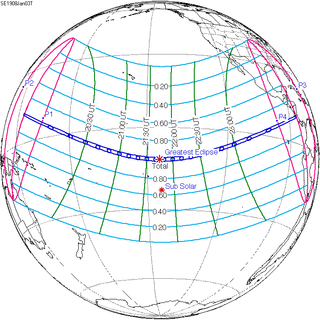Solar eclipse of January 3, 1908
| Solar eclipse of January 3, 1908 | |
|---|---|
| Type of eclipse | |
| Nature | Total |
| Gamma | 0.1934 |
| Magnitude | 1.0437 |
| Maximum eclipse | |
| Duration | 254 sec (4 m 14 s) |
| Coordinates | 11°48′S 145°06′W / 11.8°S 145.1°W |
| Max. width of band | 149 km (93 mi) |
| Times (UTC) | |
| Greatest eclipse | 21:45:22 |
| References | |
| Saros | 130 (46 of 73) |
| Catalog # (SE5000) | 9299 |
A total solar eclipse occurred on January 3, 1908. A solar eclipse occurs when the Moon passes between Earth and the Sun, thereby totally or partly obscuring the image of the Sun for a viewer on Earth. A total solar eclipse occurs when the Moon's apparent diameter is larger than the Sun's, blocking all direct sunlight, turning day into darkness. Totality occurs in a narrow path across Earth's surface, with the partial solar eclipse visible over a surrounding region thousands of kilometres wide.
The eclipse was observed by astronomer William Wallace Campbell of Lick Observatory, viewed from Flint Island, Kiribati:
Each member in a semester series of solar eclipses repeats approximately every 177 days and 4 hours (a semester) at alternating nodes of the Moon's orbit.
It is a part of Saros cycle 130, repeating every 18 years, 11 days, containing 73 events. The series started with partial solar eclipse on August 20, 1096. It contains total eclipses from April 5, 1475 through July 18, 2232. The series ends at member 73 as a partial eclipse on October 25, 2394. The longest duration of totality was 6 minutes, 41 seconds on July 11, 1619.
...
Wikipedia

